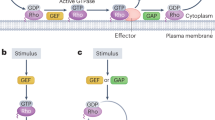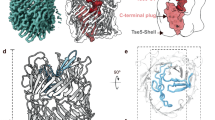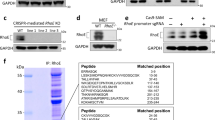Abstract
Certain bacterial toxins and type-III-translocated virulence factors have a peculiar property: they exert part of their actions by modulating Rho GTPases. These toxins target the actin cytoskeleton of host cells and reorganize it to their own advantage, either to facilitate macropinocytosis, which is required for invasive bacteria to enter cells, or to block pathogen sequestration by macrophages. In addition, by acting on Rho GTPases, bacteria may also interfere with the fate of host cells, favoring survival or death depending on their needs. Rho GTPases control the activation of NF-κB, which is involved in the expression of antiapoptotic proteins and mediates immunological responses as well. Here, we give a perspective on how NF-κB may participate in linking Rho-acting toxins and apoptosis.
Similar content being viewed by others
Log in or create a free account to read this content
Gain free access to this article, as well as selected content from this journal and more on nature.com
or
Abbreviations
- GEF:
-
guanine exchange factor
- GAP:
-
GTPase activating protein
- CdA:
-
Clostridium difficile toxin A
- CdB:
-
Clostridium difficile toxin B
- LT:
-
Letal Toxin
- CNF1:
-
cytotoxic necrotizing factor 1
- CNF2:
-
cytotoxic necrotizing factor 2
- DNT:
-
Dermonecrotizing toxin
- NF-κB:
-
nuclear factor-kB
- ExoS:
-
exoenzyme S
- IL:
-
interleukin
- APC:
-
Antigen Presenting Cell
- GDI:
-
guanine dissociation inhibitor
- IAPs:
-
inhibitors of apoptosis proteins
References
Schiavo G and van der Goot FG (2001) The bacterial toxin toolkit. Nature 2: 530–537
Weinrauch Y and Zychlinsky A (1999) The induction of apoptosis by bacterial pathogens. Annu. Rev. Microbiol. 53: 155–187
Nelson KL, Brodsky RA and Buckley JT (1999) Channels formed by subnanomolar concentrations of the toxin aerolysin trigger apoptosis of T lymphomas. Cell Microbiol. 1: 69–74
Muller A, Rassow J, Grimm J, Machuy N, Meyer TF and Rudel T (2002) VDAC and the bacterial porin PorB of Neisseria gonorrhoeae share mitochondrial import pathways. EMBO J. 21: 1916–1929
Bantel H, Sinha B, Domschke W, Peters G, Sculze-Osthoff K and Janicke RU (2001) Alpha-toxin is a mediator of Staphylococcus aureus-induced cell death and activates caspases via the intrinsic death pathway independently of death receptor signalling. J Cell Biol. 155: 637–648
Galmiche A, Rassow J, Doye A, Cagnol S, Chambard JC, Contamin S, de Thillot V, Just I, Ricci V, Solcia E, Van Obberghen E and Boquet P (2000) The N-terminal 34 kDa fragment of Helicobacter pylori vacuolating cytotoxin targets mitochondria and induces cytochrome c release. EMBO J. 19: 6361–6370
Lavoie PM, McGrath H, Shoukry NH, Cazenave PA, Sekaly RP, Thibodeau J (2001) Quantitative relationship between MHC class II-superantigen complexes and the balance of T cell activation versus death. J. Immunol. 166:7229–7237
Takai Y, Sasaki T and Matozaki T (2001) Small GTP-binding proteins. Physiol. Rev. 81: 153–208
Hall A (1998) Small GTPases and the actin cytoskeleton. Science 279: 509–514
Symons M and Settleman J (2000) Rho family GTPases: more than simple switches. Trends Cell Biol. 10: 415–419
Coleman ML and Olson MF (2002) Rho GTPase signalling pathways in the morphological changes associated with apoptosis. Cell Death Differ. 9: 493–504
Just I, Hofman F and Aktories K (2000) Molecular mechanisms of action of the large Clostridial cytotoxins. In Bacterial Proteins Toxins (Handbook of Experimental Pharmacology, vol. 145), Aktories K and Just I, eds (Berlin: Springer) pp. 307–327
Aktories K, Barth, H and Just I (2000) Clostridium botulinum C3 exoenzyme and C3-like transferases. In Bacterial Proteins Toxins (Handbook of Experimental Pharmacology, vol. 145), Aktories K and Just I, eds (Berlin: Springer) pp. 207–225
Popoff MR, Chaves-Olarte E, Lemichez E, von Eichel-Streiber C, Thelestam M, Chardin P, Cussac D, Antonny B, Chavrier P, Flatau G, Giry M, de Gunzburg J and Boquet P (1996) Ras, Rap and Rac small GTP-binding proteins are targets for Clostridium sordellii lethal toxin glucosylation. J. Biol. Chem. 271: 10217–10224
Fiorentini C, Donelli G, Nicotera P and Thelestam M (1993) Clostridium difficile toxin A elicits Ca2+-independent cytotoxic effects in cultured normal rat intestinal cript cells. Infect. Immun. 61: 3988–3993
Mahida YR, Makh S, Hyde S, Gray T and Borriello SP (1996) Effect of Clostridium difficile toxin A on human intestinal epithelial cells: induction of interleukin 8 production and apoptosis after cell detachment. Gut 38: 337–347
Mahida YR, Galvin A, Makh S, Hyde S, Sanfilippo L, Borriello SP and Sewell HF (1998) Effect of Clostridium difficile toxin A on human colonic lamina propria cells: early loss of macrophages followed by T-cell apoptosis. Infect. Immun. 66: 5462–5469
Fiorentini C, Fabbri A, Falzano L, Fattorossi A, Matarrese P, Rivabene R and Donelli G (1998a) Clostridium difficile toxin B induces apoptosis in intestinal cultured cells. Infect. Immun. 66: 2660–2665
Le Gall M, Chambard JC, Breittmayer JP, Grall D, Pouyssegur J, and Van Obberghen-Schilling E (2000) The p42/p44 MAP kinase pathway prevents apoptosis induced by anchorage and serum removal. Mol. Biol. Cell 11: 1103–1112
Anderson RJ, Ray CJ and Popoff MR (2000) Evidence for rho protein regulation of renal tubular epithelial cell function. Kidney Int. 58: 1996–2006
Gomez J, Martinez C, Giry M, Garcia A and Rebollo A (1997) Rho prevents apoptosis through Bcl-2 expression: implications for interleukin-2 receptor signal transduction. Eur. J. Immunol. 27: 2793–2799
Moorman JP, Bobak DA and Hahn CS (1996) Inactivation of the small GTP binding protein Rho induces multinucleate cell formation and apoptosis in murine T lymphoma EL4. J. Immunol. 156: 4146–4153
Bobak D, Moorman J, Guanzon A, Gilmer L and Hahn C (1997) Inactivation of the small GTPase Rho disrupts cellular attachment and induces adhesion-dependent and adhesion-independent apoptosis. Oncogene 15: 2179–2189
Henning SW, Galandrini R, Hall A and Cantrell DA (1997) The GTPase Rho has a critical regulatory role in thymus development. EMBO J. 16: 2397–2407
Calderon GM, Torres-Lopez J, Lin TJ, Chavez B, Hernandez M, Munoz O, Befus AD and Enciso AJ (1998) Effects of toxin A from Clostridium difficile on mast cell activation and survival. Infect. Immun. 66: 2755–2761
Subauste MC, Von Herrath M, Benard V, Chamberlain CE, Chuang TH, Chu K, Bokoch GM and Hahn KM (2000) Rho family proteins modulate rapid apoptosis induced by cytotoxic T lymphocytes and Fas. J. Biol. Chem. 275: 9725–9733
Parlato S, Giammarioli AM, Logozzi M, Lozupone F, Matarrese P, Luciani F, Falchi M, Malorni W and Fais S (2000) CD95 (APO-1/Fas) linkage to the actin cytoskeleton through ezrin in human T lymphocytes: a novel regulatory mechanism of the CD95 apoptotic pathway. EMBO J. 19: 5123–5134
Linseman DA, Laessing T, Meintzer MK, McClure M, Barth H, Aktories K and Heindenreich (2001) An essential role for Rac/Cdc42 GTPases in cerebellar granule neuron survival. J. Biol. Chem. 276: 39123–39131
Jiang K, Coppola D, Crespo NC, Nicosia SV, Hamilton AD, Sebti SM and Cheng JQ (2000) The phosphoinositide 3-OH kinase/AKT2 pathway as a critical target for farnesyltransferase inhibitor-induced apoptosis. Mol. Cell Biol. 20: 139–148
He D, Hagen SJ, Pothoulakis C, Chen M, Medina ND, Warny M and LaMont JT (2000) Clostridium difficile toxin A causes early damage to mitochondria in cultured cells. Gastroenterology 119: 139–150
Qa Dan M, Ramsey M, Daniel J, Spyres LM, Safiejko-Mroczka B, Ortiz-Leduc W and Ballard JD (2002) Clostridium difficile toxin B activates dual caspase-dependent and caspase-independent apoptosis in intoxicated cells. Cell. Microbiol. 4: 425–434
Boquet P and Fiorentini C (2000) The cytotoxic necrotizing factor 1 from Escherichia coli. In Bacterial Proteins Toxins (Handbook of Experimental Pharmacology, vol. 145), Aktories K and Just I, eds (Berlin: Springer) pp. 361–379
Fiorentini C, Matarrese P, Straface E, Falzano L, Fabbri A, Donelli G, Cossarizza A, Boquet P and Malorni W (1998) Toxin-induced activation of Rho GTP-binding protein increases Bcl-2 expression and influences mitochondrial homeostasis. Exp. Cell. Res. 242: 341–350
Fiorentini C, Matarrese P, Straface E, Falzano L, Donelli G, Boquet P and Malorni W (1998) Rho-dependent cell spreading activated by E. coli cytotoxic necrotizing factor 1 hinders apoptosis in epithelial cells. Cell Death Differ. 5: 921–929
Mills M, Meysick KC and O'Brien AD (2000) Cytotoxic necrotizing factor type 1 of uropathogenic Escherichia coli kills cultured human uroepithelial 5637 cells by an apoptotic mechanism. Infect. Immun. 68: 5869–5880
Cammarano MS and Minden A (2001) Dbl and the Rho GTPases activate NFkB by IkB kinase (IKK)-dependent and IKK-independent pathways. J. Biol. Chem. 276: 25876–25882
Cornelis GR and Van Gijsegem F (2000) Assembly and function of type III secretory systems. Ann. Rev. Microbiol. 54: 735–774
Knodler LA, Celli J and Finlay BB (2001) Pathogenic trickery: deception of host cell processes. Nature 2: 578–588
Steele-Mortimer O, Knodler LA and Finlay BB (2000) Poisons, ruffles and rockets: bacterial pathogens and the host cell cytoskeleton. Traffic 1: 107–118
Goehring UM, Schmidt G, Pederson KJ, Aktories K and Barbieri JT (1999) The N-terminal domain of Pseudomonas aeruginosa exoenzyme S is a GTPase-activating protein for Rho GTPases. J. Biol. Chem. 274: 36 369–36 372
Von Pawel-Rammingen U, Telepnev MV, Schmidt G, Aktories K, Wolf-Watz H and Rosqvist R (2000) GAP activity of the Yersinia YopE cytotoxin specifically targets the Rho pathway: a mechanism for disruption of actin microfilament structure. Mol. Microbiol. 36: 737–748
Shao F, Merritt PM, Bao Z, Innes RW and Dixon JE (2002) A Yersinia effector and a Pseudomonas avirulence protein define a family of cysteine proteases functioning in bacterial pathogenesis. Cell 109: 575–588
Zychlinsky A, Prevost MC, Holland IB and Sansonetti PJ (1992) Shigella flexneri induces apoptosis in infected macrophages. Nature 358: 167–169
Zychlinsky A, Kenny B, Menard R, Prevost MC, Holland IB and Sansonetti PJ (1994) IpaB mediates macrophage apoptosis induced by Shigella flexneri. Mol. Microbiol. 11: 619–627
Hersh D, Monack DM, Smith MR, Ghori N, Falkow S and Zychlinsky A (1999) The Salmonella invasin SipB induces macrophage apotosis by binding to caspase-1. Proc Natl. Acad. Sci. 96: 2396–2401
Jesenberger V, Procyk KJ, Yuan J, Reipert S and Baccarini M (2000) Salmonella-induced caspase-2 activation in macrophages: a novel mechanism in pathogen-mediated apoptosis. J. Exp. Med. 192: 1035–1045
Cornelis GR (2000) Molecular and cell biology aspects of plague. Proc. Natl. Acad. Sci. 97: 8778–8783
Schneider DS (2002) Plant immunity and film noir: what gumshoe detectives can teach us about plant–pathogen interactions. Cell 109: 537–540
Ruckdeschel K, Harb S, Roggeznkamp A, Hornef M, Zumbihl R, Kohler S, Heesemann J and Rout B (1998) Yersinia enterocolitica impairs activation of transcription factor NF-kappaB: involvement in the induction of programmed cell death and the suppression of the macrophage tumor necrosis factor alpha production. J. Exp. Med. 187: 1069–1079
Denecher G, Declercq W, Geuijen CA, Boland A, Benabdillah R, van Gurp M, Sory MP, Vandenabeele P and Cornelis GR (2001) Yersinia enterocolitica YopP-induced apoptosis of macrophages involves the apoptotic signaling cascade upstream of bid. J. Biol. Chem. 276: 19 706–19 714
Perona R, Montaner S, Saniger L, Sanchez-Perez I, Bravo R and Lacal JC . (1997) Activation of the nuclear factor-kappaB by Rho, CDC42, and Rac-1 proteins. Genes Dev. 11:463–475
Tato CM and Hunter CA (2002) Host–pathogen interactions: subversion and utilization of the NF-κB pathway during infection. Infect. Immun. 70: 3311–3317
Acknowledgements
We are grateful to W. Malorni for a critical reading of the manuscript.
Author information
Authors and Affiliations
Corresponding author
Additional information
Edited by P Nicotera
Rights and permissions
About this article
Cite this article
Fiorentini, C., Falzano, L., Travaglione, S. et al. Hijacking Rho GTPases by protein toxins and apoptosis: molecular strategies of pathogenic bacteria. Cell Death Differ 10, 147–152 (2003). https://doi.org/10.1038/sj.cdd.4401151
Received:
Revised:
Accepted:
Published:
Issue date:
DOI: https://doi.org/10.1038/sj.cdd.4401151
Keywords
This article is cited by
-
Reversible senescence of human colon cancer cells after blockage of mitosis/cytokinesis caused by the CNF1 cyclomodulin from Escherichia coli
Scientific Reports (2018)
-
Enlarged dendritic spines and pronounced neophobia in mice lacking the PSD protein RICH2
Molecular Brain (2016)
-
The Rho-activating CNF1 toxin from pathogenic E. coli: A risk factor for human cancer development?
Infectious Agents and Cancer (2008)
-
Clostridium difficile toxin A-induced apoptosis is p53-independent but depends on glucosylation of Rho GTPases
Apoptosis (2007)
-
Bacterial cytotoxins: targeting eukaryotic switches
Nature Reviews Microbiology (2005)



